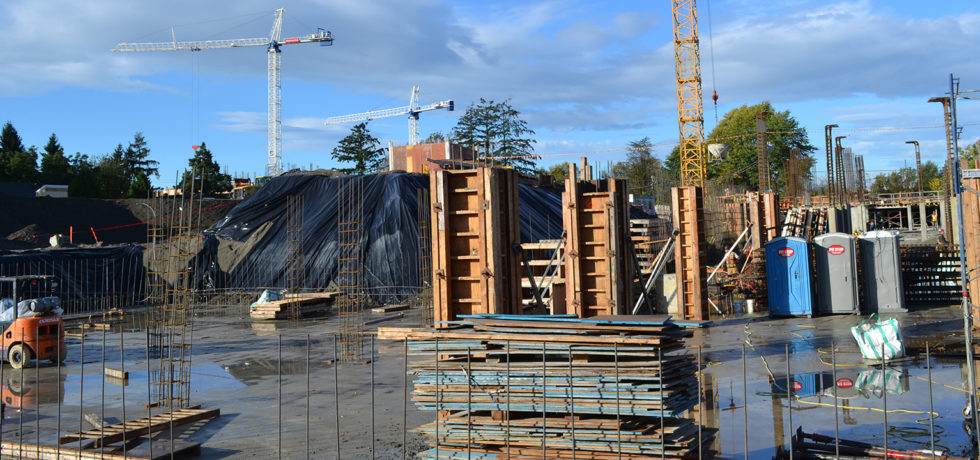Category
- Concrete Best Practices
The construction industry continually faces challenges in ensuring the durability and integrity of concrete structures, particularly when it comes to waterproofing new foundations or repairing damaged ones.
A recent World of Concrete 360 webinar focused on this critical issue, offering valuable insights for architects, engineers, and contractors. With proper preplanning, concrete specifiers and contractors can adopt a practical approach.
This blog post distills the key points from the webinar, emphasizing the challenges, standards, and practical strategies for waterproofing concrete foundations.
Modern Waterproofing Challenges
As prime construction land in North America becomes harder to find, more structures are being built in challenging environments, such as areas with poor soil conditions or high water tables.
These realities, combined with the increasing demand for watertight structures to comply with air barrier regulations, underscore the need for effective waterproofing solutions.
Waterproofing Solutions for Concrete Foundations
Approaches to waterproofing a concrete foundation will differ depending on whether it is a new construction or repair project. Either way requires careful consideration of materials, application methods, and environmental conditions.
New Construction
Pre-construction is the time to discuss waterproofing options for new foundation construction. Contractors can bring up the subject of waterproofing when reviewing several sections in the NRMCA/ASCC Checklist for the Concrete Pre-Construction Conference.
In summary, methods for constructing a waterproof foundation should focus on concrete mix designs, water stops, and surface treatments.
1. Comprehensive Planning and Design
Engage in thorough planning and design phases to incorporate waterproofing strategies from the outset. Utilize resources like ACI guidelines and SWRI technical notes for best practices.
Consider local environmental conditions, such as soil types and water table levels, to inform waterproofing methods.
2. Selecting the Right Waterproofing System
Choose integral waterproofing admixtures, like Kryton’s Krystol Internal Membrane (KIM) technology, for its ability to make concrete inherently water-resistant. Krystol technology reacts with moisture to form insoluble needle-shaped crystals that fill capillary pores and micro-cracks in the concrete and block the pathways for water and waterborne contaminants.
Unlike other crystalline solutions that react with free lime that eventually depletes over time, KIM chemically reacts with water and unhydrated cement particles. Any moisture introduced over the lifespan of the concrete will initiate crystallization, ensuring permanent waterproofing and watertightness protection.
For external applications, opt for high-quality membranes and coatings that suit the project’s specific needs. Look for products that meet ASTM International standards (ASTM D5385 for waterproofing membranes).
3. Proper Installation of Water Stops and Joint Fillers
Install water stops and joint fillers at construction joints to prevent water passage. Products like Krytonite Swelling Waterstop are effective in creating a watertight seal. Ensure correct installation practices are followed, as improper placement can lead to failures in the waterproofing system.
4. Quality Control and Testing
Before full-scale application, it might be worthwhile conducting tests with specific products such as admixtures, membranes, and coatings to assess their compatibility with the concrete mix, application conditions, and long-term performance expectations. Adjust mix designs or application techniques based on test results to optimize the waterproofing efficacy.
5. Review Detailed Application Guides
Manufacturers often provide detailed application guides and technical support for their products. For instance, Kryton’s technical manuals offer insights into mixing, applying, and curing crystalline waterproofing products to achieve optimal results, and, should questions arise at any time, our customer service is second to none.
Foundation Repair
There can be instances when a concrete foundation leaks. Managing the owner’s expectations concerning the scope of work and repair options is best controlled with an effective pre-construction meeting to discuss the extent of the damage, the repair options, costs, and risks.
1. Assessment and Evaluation
Start with a thorough assessment of the existing structure to identify all sources of water ingress and related damage. Use tools and techniques to map out cracks, voids, and other defects that compromise the foundation’s integrity.
2. Choosing Appropriate Repair Materials
Select repair materials and methods that are compatible with the existing concrete and the specific conditions of the project.
Surface-applied crystalline waterproofing products like Krystol T1 Concrete Waterproofing or Krystol Broadcast can be suitable for negative-side waterproofing, offering an effective solution for inaccessible external surfaces.
For an even more cost-effective solution, Hydrostop Sealer is a clear, water-based liquid that is sprayed or rolled onto horizontal or vertical surfaces. It contains a unique blend of silane and siloxane compounds that chemically react with silicates below the surface of the substrate to form an insoluble, water-repellent barrier.
3. Addressing Structural Cracks and Joints
Repair structural cracks with appropriate fillers or injectables that offer waterproofing properties. Ensure that repairs address both the symptom (the crack) and the underlying cause. Also consider retrofitting water stops in joints where feasible, using modern materials designed for easy installation in repair scenarios.
4. Implementing Moisture Management Solutions:
In cases of high moisture content or when dealing with vapor transmission issues, apply coatings or membranes that can handle these conditions without compromising the waterproofing layer. Ensure that repairs include considerations for managing moisture in the surrounding soil, possibly incorporating drainage solutions to reduce hydrostatic pressure.
Kryton has an all-in-one solution for concrete repairs, Krystol Leak Repair System, which tackles the damage in a three-step process:
- Prepare a chase by chiseling into the concrete
- Stop flowing water with Krystol Plug
- Fill the chase flush to the surface with Krystol Repair Grout
After completing the leak repair, the Krystol T1 Concrete Waterproofing will protect the entire structure against the continued ingress of water and further concrete deterioration, as well as reduce the likelihood of further leaks developing in the structure.
Waterproofing Standards
The American Concrete Institute (ACI) offers critical guidelines and standards for waterproofing including:
- ACI 515.1R-85: Guide to the Use of Waterproofing, Dampproofing, Protective, and Decorative Barrier Systems for Concrete
- ACI PRC-546-14: Guide to Concrete Repair
These documents discuss recommended ways to mitigate and repair cracks and select appropriate treatments to restrict water penetration into concrete structures. Adhering to these standards ensures that waterproofing efforts are grounded in proven practices and up-to-date knowledge.
Further, the Sealant, Waterproofing and Restoration Institute (SWRI) provides contractor-developed technical notes for pre-construction meetings involving general contractors, design professionals, and owners.
Summary
By selecting reputable products and following best practices in application and quality control, construction professionals can effectively address the challenges of waterproofing, ensuring the durability and integrity of structures.
For more details, watch our on-demand webinar with World of Concrete: Waterproofing a Concrete Foundation. Contractors, architects, and engineers who attend this webinar will get a Certificate of Attendance for self-reporting certification purposes.




